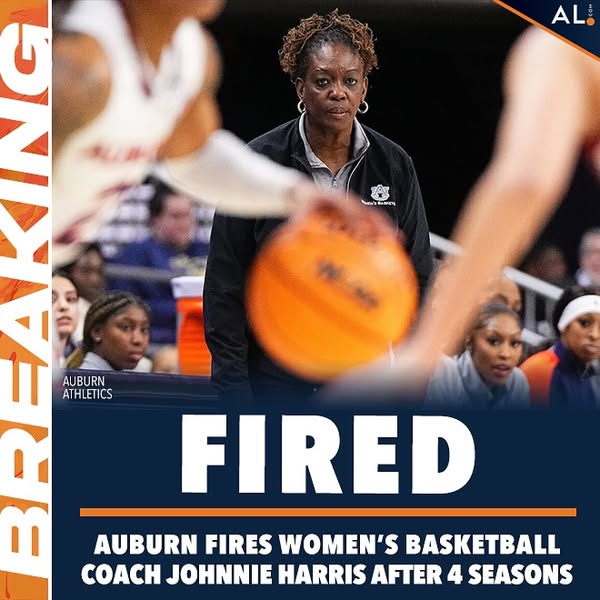
Head coach of Auburn’s women’s basketball team, Johnnie Harris, was sacked after four seasons with the Tigers, going 58-63.
In a world where the pressure to win is as high as the stakes, coaching in college basketball often involves navigating a tightrope of expectations, results, and leadership. The recent sacking of Johnnie Harris, head coach of Auburn University’s women’s basketball team, after four seasons, is a stark reminder of the fine line coaches walk. Harris, who was tasked with turning around a program that had faced numerous challenges, ended her tenure with a 58-63 record, and while some might consider it a modest result, the decision to part ways with her carries significant implications.
This article seeks to explore the factors behind the firing of Johnnie Harris, examining her tenure at Auburn, the broader context of Auburn women’s basketball, and the future of the program moving forward.
The Background: Who is Johnnie Harris?
Johnnie Harris took over as Auburn’s women’s basketball head coach in 2021, succeeding Terri Williams-Flournoy, who had been at the helm for nearly a decade. Harris was no stranger to high-level basketball, having spent significant time as an assistant coach under notable figures like Vic Schaefer at Mississippi State, where she helped the Bulldogs reach multiple NCAA Tournaments, including a national runner-up finish in 2017. Her experience and coaching acumen were part of the reason she was hired to lead Auburn’s women’s basketball program.
Harris came to Auburn with the task of revitalizing a program that had shown flashes of potential but ultimately fell short in terms of sustained success. Under Williams-Flournoy, Auburn had a few strong seasons but had generally struggled to break into the upper echelon of the Southeastern Conference (SEC), one of the toughest leagues in women’s college basketball. The hope was that Harris, with her recruiting connections and knowledge of how to build a competitive program, would be able to bring the Tigers back to prominence.
The Tenure: Performance Under Harris
In her four years at Auburn, Harris oversaw a period of significant change for the program. Her record, 58-63, reflects both her challenges and some small successes along the way.
-
Year One: Building from Scratch
Harris’s first year was a rebuilding one. She inherited a roster that had lost key players and lacked depth in many areas. The season ended with a 10-15 record, and though the Tigers showed glimpses of potential, it was clear that a full roster overhaul was needed to implement Harris’s vision. This first year was always going to be a transitional period, and it was difficult to assess Harris’s abilities based on the results of that season alone.
-
Year Two: Modest Improvement
The second season saw slight improvement, with the Tigers finishing 11-14. While the team still struggled to contend in the SEC, there were noticeable signs of progress. Harris started implementing a more aggressive defensive scheme, and Auburn showed more competitive resilience against conference opponents. However, a lack of offensive consistency and the inability to consistently win close games continued to plague the team.
-
Year Three: The Most Competitive Season
The third season was arguably Harris’s most competitive year with Auburn. The Tigers finished 16-13, a modest but significant improvement. Harris’s squad showed that they could compete against the best teams in the SEC, even if they still lacked the depth and star power of teams like South Carolina or Tennessee. Auburn managed to win a few key games against ranked opponents and showed the type of grit and determination that Harris was known for as an assistant coach. Yet, even in this season, the Tigers couldn’t find a way to break through into the upper tier of the conference standings.
-
Year Four: A Step Back
The fourth season proved to be a challenging one. Despite some positive momentum from the previous year, Auburn regressed, finishing with a 21-21 record and struggling to maintain the level of competitiveness they had shown in year three. Injuries to key players, combined with inconsistent performances, left the Tigers floundering and ultimately led to a disappointing season. While the team was competitive in some games, they failed to win crucial matchups that would have helped them reach the postseason.
The Decision to Part Ways: Why Was Harris Fired?
Despite her experience and the gradual improvements the team showed under her leadership, the decision to fire Johnnie Harris was ultimately based on several key factors:
-
Failure to Achieve Long-Term Success
One of the most critical reasons for Harris’s firing was the lack of sustained success. Despite an influx of talent, improvements on the court, and occasional flashes of brilliance, Auburn’s women’s basketball program failed to achieve long-term success in the highly competitive SEC. In a conference known for its powerhouse programs, Auburn had been relegated to the middle or bottom tier during Harris’s tenure. The SEC, with its elite programs such as South Carolina, Tennessee, and LSU, demands nothing less than consistent high-level performance. Harris was unable to deliver on that front, and Auburn’s administration likely felt that more was expected given her background and experience.
-
Inability to Compete at a High Level in the SEC
The SEC is the toughest conference in women’s college basketball, and while Harris showed potential in her ability to compete against mid-level and lower-tier SEC teams, she was unable to consistently challenge the top teams. Auburn’s poor performance in the conference, especially in critical matchups against highly-ranked teams, played a significant role in the decision. It became clear that Harris’s system was not translating into consistent success against the SEC’s elite programs.
-
Recruiting Challenges
Recruiting is often the key to success in college basketball, and it became evident that Harris’s recruiting efforts were not yielding the desired results. While Harris was known for her ability to recruit well, particularly in her time at Mississippi State, Auburn’s recruiting under her leadership struggled to produce the type of star players that are needed to compete at the highest levels. Auburn’s roster lacked depth and high-impact players, especially in comparison to the elite teams in the SEC. This gap in talent contributed to the team’s struggles and, ultimately, the decision to move in a new direction.
-
Pressure from Fans and Alumni
In any major college athletic program, the pressure from fans, alumni, and boosters can be immense. Auburn’s women’s basketball program has a passionate fan base that expects results. While many fans supported Harris’s efforts and saw the potential in her leadership, others became frustrated with the lack of postseason appearances and the team’s struggles in the SEC. In a results-driven environment, the inability to meet the expectations of key stakeholders can often lead to a coaching change.
-
The Need for a Fresh Start
After four seasons, it became clear that Auburn’s women’s basketball program needed a fresh start. The program had shown brief moments of promise, but without consistent performance, the Tigers were stuck in a cycle of mediocrity. The administration likely decided that a change in leadership was necessary to bring new energy and a renewed sense of purpose to the program.
What’s Next for Auburn Women’s Basketball?
With the departure of Johnnie Harris, Auburn’s women’s basketball program now faces a critical juncture in its history. The search for a new head coach will be pivotal in determining the future trajectory of the program.
Auburn will likely target a coach with a proven track record in the SEC or a similar power conference, someone who can immediately recruit high-level talent and compete at the highest levels. The next head coach will need to address several critical issues, including strengthening the team’s defense, improving offensive execution, and most importantly, recruiting players who can make an immediate impact.
Additionally, the next coach will have to work to restore the confidence of Auburn’s fan base and alumni, who are eager to see the program return to prominence. Auburn has a rich basketball tradition, and the potential for success is there, but it will take the right leader to harness that potential and turn it into tangible results.





